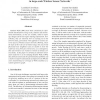Free Online Productivity Tools
i2Speak
i2Symbol
i2OCR
iTex2Img
iWeb2Print
iWeb2Shot
i2Type
iPdf2Split
iPdf2Merge
i2Bopomofo
i2Arabic
i2Style
i2Image
i2PDF
iLatex2Rtf
Sci2ools
WOWMOM
2009
ACM
2009
ACM
Improving partial cover of Random Walks in large-scale Wireless Sensor Networks
Random Walks (RWs) have been considered for information dissemination in large scale, dynamic and unstructured environments, as they are scalable, robust to topology changes and do not require topology information. Nevertheless, they are relatively slow in reaching out to the network nodes, particularly when applied to wireless networks (such as Wireless Sensor Networks (WSNs)), where the steps of the walk are of limited range, they reach only physically-close neighbours and are unable to move the walker far away from just covered area; as a consequence, time and resources are wasted in revisits of already covered nodes. In this paper we develop an innovative mechanism (referred to as the Jumping Random Walk (J-RW)) that alleviates drastically the aforementioned problems and is shown to improve substantially (compared to the RW) the cover time/overhead or coverage of WSNs modelled as a random geometric graph.
| Added | 28 May 2010 |
| Updated | 28 May 2010 |
| Type | Conference |
| Year | 2009 |
| Where | WOWMOM |
| Authors | Leonidas Tzevelekas, Ioannis Stavrakakis |
Comments (0)

